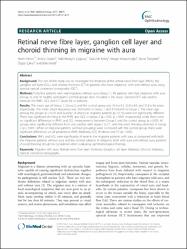Retinal nerve fibre layer, ganglion cell layer and choroid thinning in migraine with aura

View/
Date
2014Author
Ekinci, MetinCeylan, Erdinç
Çağatay, Halil Hüseyin
Keleş, Sadullah
Hüseyinoğlu, Nergiz
Tanyıldız, Burak
Kartal, Baki
Çakıcı, Özgür
Metadata
Show full item recordAbstract
Background: The aim of this study was to investigate the thickness of the retinal nerve fiber layer (RNFL), the ganglion cell layer (GCL), and choroid thickness (CT) in patients who have migraines, with and without aura, using spectral optical coherence tomography (OCT). Methods: Forty-five patients who had migraines without aura (Group 1), 45 patients who had migraines with aura (Group 2), and 30 healthy participants (control group) were included in the study. Spectral OCT was used to measure the RNFL, GCL and CT values for all patients. Results: The mean age of Group 1, Group 2, and the control group was 34.6 +/- 4.3, 32.8 +/- 4.9, and 31.8 +/- 4.6 years, respectively. The mean attack frequency was 3.6/month in Group 1 and 3.7/month in Group 2. The mean age among the groups (p = 0.27) and number of attacks in migraine patients (p = 0.73) were not significantly different. There was significant thinning in the RNFL and GCL in Group 2 (p < 0.05, p < 0.001 respectively), while there were no significant differences in RNFL and GCL measurements between Group 1 and the control group (p > 0.05). All groups were significantly different from one another with respect to CT, with the most thinning observed in Group 2 (p < 0.001). When all migraine patients (without grouping) were compared with the control group, there were significant differences on all parameters: RNFL thickness, GCC thickness and CT (p < 0.05). Conclusions: RNFL and GCL were significantly thinner in the migraine patients with aura as compared with both the migraine patients without aura and the control subjects. In migraine, both with aura and without aura, patients' choroid thinning should be considered when evaluating ophthalmological findings.

















